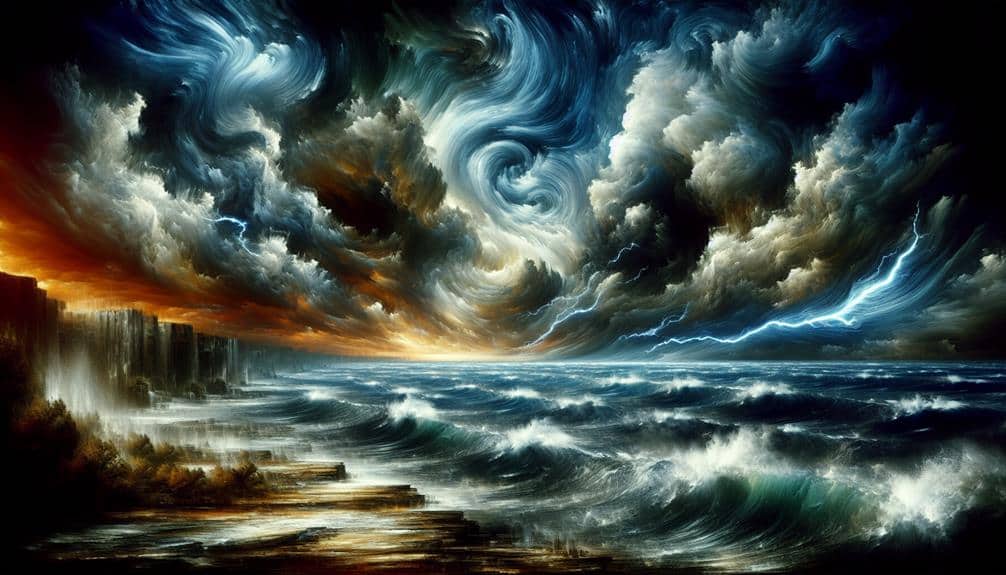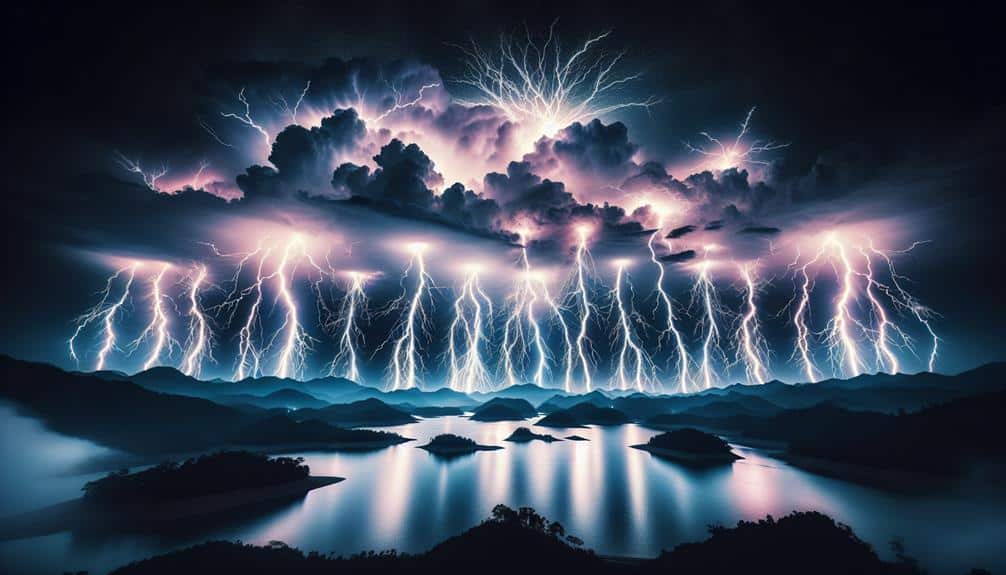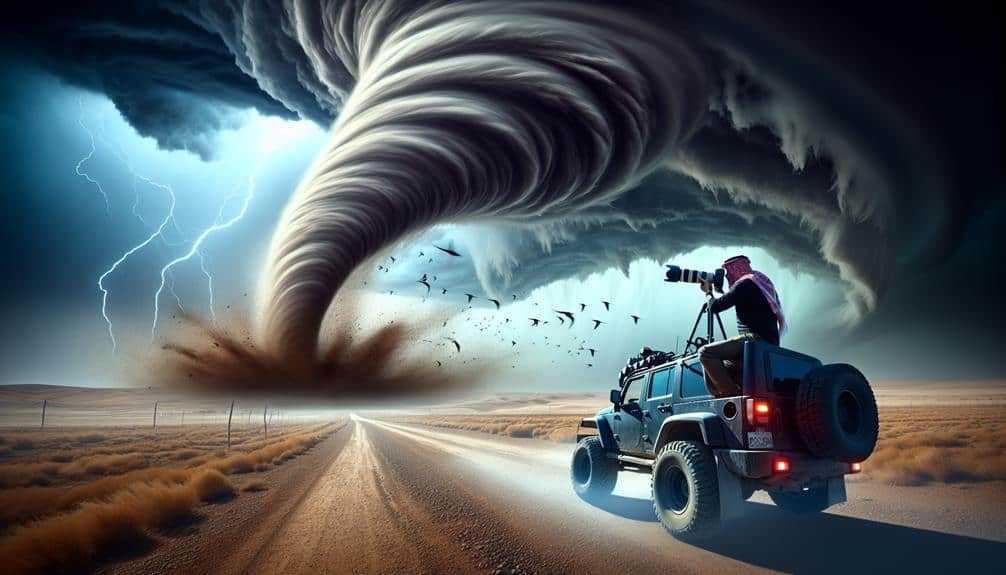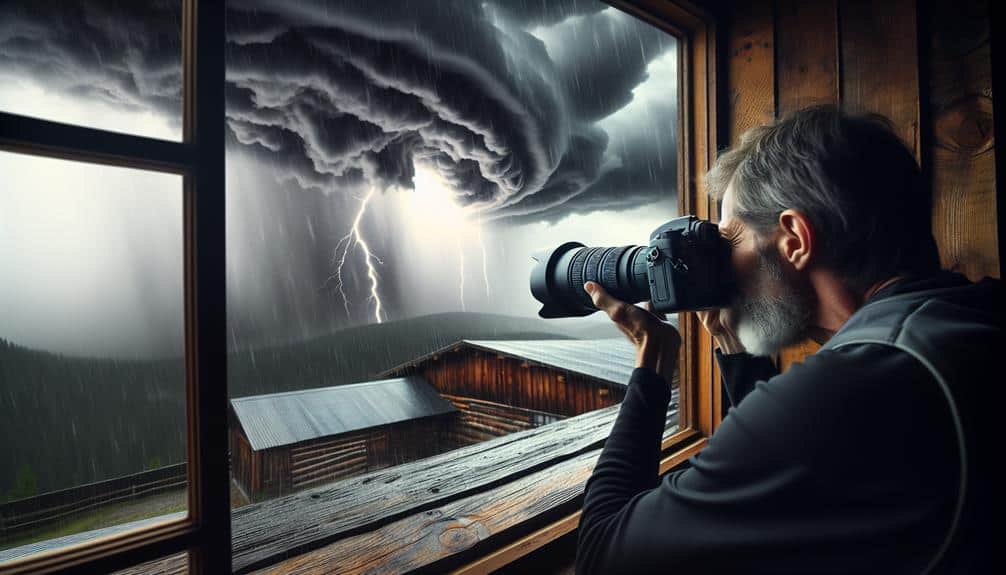To capture dynamic wind patterns in storm photography, we need to start by understanding how wind behavior is influenced by Earth's rotation and pressure gradients, particularly the Coriolis effect. We'll need sturdy tripods and weather-sealed camera bodies to handle harsh conditions, along with wide-angle and telephoto lenses for versatility. Mastering camera settings like ISO, shutter speed, and aperture is pivotal for balancing light and freezing wind-driven elements. Composition techniques such as the rule of thirds and leading lines help highlight the storm's raw energy. Post-processing enhances details, adjusts colors, and can even add motion blur, transforming our captures. There's more to gain from mastering these elements.
Key Points
- Use fast shutter speeds to freeze wind-driven elements and capture sharp details.
- Employ wide-angle lenses to encompass the vastness and movement of stormy skies.
- Adjust ISO and aperture settings to balance light sensitivity and depth of field.
- Stabilize your camera with a sturdy tripod to maintain clarity in strong winds.
Understanding Wind Behavior
To effectively capture dynamic wind patterns in storm photography, we must first explore the intricacies of wind behavior and its underlying meteorological principles. By understanding how wind direction and speed interact with weather patterns, we can anticipate and photograph these dramatic natural phenomena with greater precision and creativity.
Wind direction is influenced by the Earth's rotation and pressure gradients. The Coriolis effect causes winds to curve, resulting in distinct patterns like trade winds, westerlies, and polar easterlies. Recognizing these patterns helps us predict how storms will develop and move.
Wind speed, on the other hand, depends on the pressure difference between high and low-pressure systems. The steeper the gradient, the faster the wind.
Weather forecasts provide invaluable data on upcoming storms, including expected wind direction and speed. By analyzing these forecasts, we can plan our shoots to coincide with the most dynamic conditions. For example, the shift zones between high and low-pressure areas often produce the most visually striking wind effects, such as swirling clouds or debris movement.
Understanding these principles enables us to harness the power of nature, turning unpredictable weather patterns into compelling storm photography. This knowledge not only enriches our craft but also offers a deeper connection to the elemental forces that shape our world.
Choosing the Right Gear
Selecting the right gear is important for capturing the full intensity and drama of dynamic wind patterns during storm photography. To start, we need a sturdy tripod to withstand the wind's force. This guarantees stability, especially when gusts are strong and unpredictable. Pair this with a weather-sealed camera body that can endure harsh conditions without compromising performance.
Our choice of lens is vital. Wide-angle lenses allow us to encompass the vastness of the storm, making it easier to capture the sweeping wind direction and speed. However, telephoto lenses can be useful for isolating specific elements like debris or swaying trees.
Filters also play a significant role. Neutral density filters help us manage exposure during daylight storms, enabling longer shutter speeds to blur wind-driven elements like grass or rain. Polarizing filters reduce glare and enhance contrast, bringing out the intricate details in clouds and wind movements.
We can't overlook the significance of a reliable weather app. Understanding wind direction and speed informs our positioning and composition choices. Additionally, having a remote shutter release minimizes camera shake, guaranteeing sharp images even in the fiercest conditions.
Mastering Camera Settings
Mastering camera settings is vital for capturing the raw power and intricate details of dynamic wind patterns in storm photography. To truly harness the spirit of the storm, we need to fine-tune our exposure settings.
Start by adjusting the ISO to balance noise and light sensitivity. Typically, a lower ISO (around 100-400) works well to minimize graininess in dark, stormy conditions.
Next, the shutter speed becomes our best friend; a fast shutter speed (1/1000th of a second or faster) can freeze the swirling leaves and debris, making the wind's force palpable in our shots.
Aperture control is equally important. A smaller f-stop (f/2.8 to f/5.6) allows more light in and creates a shallow depth of field, emphasizing the movement of specific elements. Conversely, a higher f-stop (f/11 or above) can capture the broader context of the storm, from the churning clouds to the wind-whipped landscape.
When it comes to focusing techniques, switching to manual focus grants us the precision we need. Auto-focus often struggles in low-contrast, turbulent scenes.
Manually focusing on a key subject, like a bending tree or a flying flag, guarantees we capture the storm's raw, dynamic energy without compromise.
Composition Techniques
While mastering camera settings is essential, understanding composition techniques enables us to frame the storm's chaos artistically, capturing the essence of its power and movement. By leveraging the rule of thirds, we can place key elements like lightning strikes or swirling clouds at intersecting points, drawing viewers' eyes naturally into the scene. This method helps maintain a dynamic balance, emphasizing both the storm's intensity and the vast sky.
Leading lines are invaluable for guiding the viewer through the photograph. Natural elements like winding roads or jagged tree lines can direct attention toward the storm's core, enhancing the feeling of being drawn into its fury. These lines create a visual journey, making the image more compelling.
Balancing light is essential in storm photography. We need to manage the contrasting light and dark areas, ensuring the highlights don't overpower the shadows. Proper light balance reveals subtle details in the clouds and wind patterns, adding depth to our compositions.
Framing techniques, such as using foreground elements like branches or buildings, can add context and scale, emphasizing the storm's magnitude. These techniques encapsulate not just the visual impact but the raw, untamed energy of nature itself, offering a profound sense of freedom.
Post-Processing Tips

Once we've captured the storm's raw energy through thoughtful composition, we can enhance these dynamic scenes further with careful post-processing techniques. Utilizing Lightroom presets and Photoshop techniques allows us to bring out the full potential of our storm photography.
First, let's tackle color correction. By adjusting the white balance in Lightroom, we can make sure the storm's hues are both dramatic and true to life. Next, exposure adjustments are essential. Increasing the exposure slightly can bring out hidden details in the shadows, while decreasing highlights prevents overexposure of lightning or bright clouds.
In Photoshop, we can use layer masks to selectively edit parts of the image, enhancing the wind's motion without affecting the entire scene. Adding a touch of motion blur to specific areas can intensify the sense of dynamic wind patterns.
To evoke the storm's raw power and drama, consider the following:
- Sharpening edges to emphasize the chaotic movement of debris.
- Adjusting contrast to highlight the interplay of light and dark areas.
- Using gradient filters to create depth and draw the eye.
- Enhancing textures to make the wind patterns more vivid.
Frequently Asked Questions
What Safety Precautions Should I Take When Photographing Storms?
When photographing storms, we should prioritize safety measures by staying informed about weather updates, positioning ourselves away from high-risk areas, and having a solid emergency plan in place to quickly evacuate if conditions worsen.
How Do I Predict the Best Time to Capture Dynamic Wind Patterns?
We often find ideal timing by coincidence, but wind direction analysis and weather forecast tools help predict it accurately. Key photography tips include monitoring these tools closely to seize the perfect moment for capturing dynamic wind patterns.
Are There Specific Locations That Are Ideal for Capturing Storm Wind Patterns?
We should focus on windy landscapes like open plains and stormy shores. These locations offer unobstructed views and dramatic skies, perfect for capturing dynamic wind patterns. The interplay of wind and terrain creates unique photographic opportunities.
What Legal Considerations Should I Be Aware of When Storm Chasing?
Coincidentally, when we're storm chasing, we must respect privacy laws and avoid trespassing. It's essential to stay informed about local regulations to guarantee our photography doesn't infringe on others' property rights or personal privacy.
How Do I Protect My Equipment From Extreme Weather Conditions?
To guarantee equipment protection during extreme weather, we use waterproof covers and robust cases. Regular gear maintenance, like checking seals and cleaning lenses, is essential. Always prioritize durable, weather-resistant gear for our storm photography adventures.


